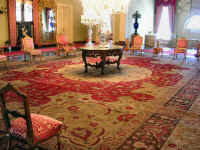One of the artistic values of 17th century is Palace Carpets.Alongside the development of the traditional Turkish carpets, a completely different type of carpet both in technique and design appears at the end of the 16th century, the Ottoman palace carpets. The conquest by the Ottomans of Tabriz in 1514 and later of Cairo in 1517 pawed the way for some new concepts, both technical and ornamental, in the art of Turkish rug making.
The carpets, first woven in Cairo between the years 1540 and 1550 reflect a combination of colors and designs reminiscent of the Mameluke carpets. But in a considerably short time the naturalistic style of the Ottoman palace carpets began to gain predominance. These carpets were not the product of a long development but had rather a sudden birth. Because of the intricate and mixed designs of these carpets and the fact that they were seldom depicted in European paintings, it is difficult to date them.
Designs using lancet leaves called “saz”, palmettes and medallions intermingling with very naturalistic motifs of tulips, hyacinths, carnations and pomegranates began to appear creating a completely different fresh effect.
Naturalistic leaves which appear in various other branches of Ottoman art also are displayed in these carpets. Also Persian (Sine) knots instead of the Turkish were preferred in making these luxury carpets with their extremely rich and elegant designs.
The resulting effect of the knotting is projecting tufts of colored yarn which make the close woven pile of the carpet. The knots of wool and cotton being very tight (200 to 700 thousand per m2), produce an effect Tike that of soft velvet. Silk was newer employed in the knots but it was used occasionally in the warp and weft; the woolen pile was often supplemented with cotton.
 The arrangement of the medallion in Persian carpets plays only a secondary role, the basic pattern appearing Tike a section cut out of an endless field. Ewen if the patch like medallions were to be removed, the general effect would stay the same. And, in fact some carpets without any medallions are much more pleasing in composition.
The arrangement of the medallion in Persian carpets plays only a secondary role, the basic pattern appearing Tike a section cut out of an endless field. Ewen if the patch like medallions were to be removed, the general effect would stay the same. And, in fact some carpets without any medallions are much more pleasing in composition.
In the 19th century Turkish carpet weaving continued to develop. Sultan Abdülhamit II in 1881 added 100 carpet looms to the factory founded by Sultan Abdülmecit in 1844 at Hereke for the weaving of cloth, and thus the production of the famous Hereke Rugs was begun. These masterpieces are still being made there.
The art of old Turkish carpet weaving is creatively continuing in the Konya, Kayseri, Sivas and Kırşehir regions, in western Anatolia in Isparta, Fethiye, Döşemealtı, Balıkesir, Yağcıbedir, Uşak, Bergama, Kula, Gördes, Milas, Çanakkale and Ezine, and in the east in the Kars and Erzurum regions.